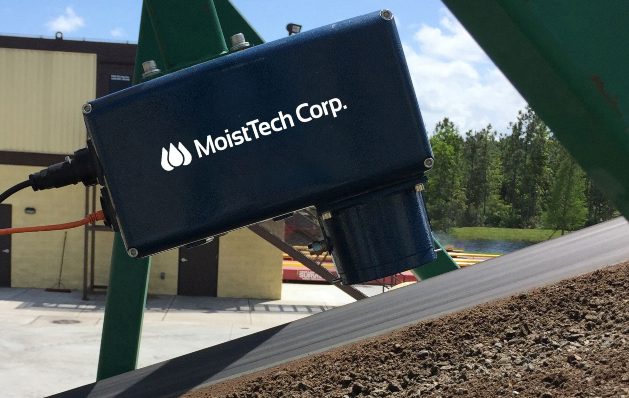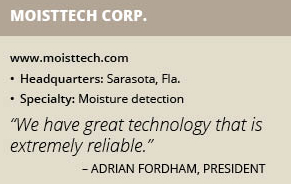
Moisture and Oil Detection Solutions for Snack Food Manufacturers
Imagine you manufacture potato chips and its vitally important to know how much moisture and oil is in the chips. Where would you go?
Adrian Fordham, president of MoistTech in Sarasota, Fla., has got you covered.
MoistTech uses near infrared (NIR) technology, a type of light source, to check the moisture of various products.
“We detect moisture using near infrared technology,” Fordham explains. “The moisture elements [water] gets excited and moves. We measure that excitement or energy.”
So, take that manufacturer of potato chips. “We can control the amount of time chips are in the fryer,” Fordham says. “We measure the moisture and the oil or fat content. A perfect chip comes out at 1.2 percent moisture. If it comes out in that amount of time for the degree of moisture, it’s a perfect chip.”
Another example is the manufacture of wood pellets, which are used for boilers and other types of heating. Ideally, wood pellets should have 9 to 12 percent moisture content. “If it’s too dry, it falls apart and if it’s too wet, it clogs up the pelletizer,” Fordham says. MoistTech’s IR3000W sensor can measure that moisture in wood pellets and other wood products.
MoistTech sensors can be mounted above a conveyor belt. Without touching the product or raw material, it can instantly measure moisture in chemicals, tobacco, snack food, textiles, animal food, human food, bioenergy, minerals and bulk materials.
MoistTech’s customers are from around the world and tend to be big players in their industries. “We have lots of major snack food manufacturers, everything in the wood industry, lots of chemicals, lot of mining and all the big players for coal and companies that use coal,” Fordham says.
That diversity of customers helps the company. “Because we are in so many industries, if one market hasn’t done well, we take off in different industries,” Fordham says. “Something is always doing well.”
MoistTech also manufactures standalone devices for use in laboratories, field work or quality control checks.
Key Player
MoistTech is a key player in the industry of moisture detection sensors, Fordham says. “It’s kind of a niche industry,” he says. “There are a few of us worldwide.”
MoistTech distinguishes itself from its competitors by the consistency of its sensors. “We have great technology that is extremely reliable,” he adds. “It has a long expected lifetime. We are also known for our service and support in correcting communications issues or helping with [customer’s] processes.”
By ‘communications,’ Fordham is referring to communications between the MoistTech sensors and the computer systems of its customers. The company is continually adapting or upgrading the software for those communications.
No Calibration Needed
MoistTech batch manufactures about 20 sensors at a time. “It keeps everything easy for us.” Fordham says. When a customer orders a sensor, staff gets one from stock, does a quality check and gets it optically balanced for the specific product the customer wants to measure the moisture.
“In most case, the customer will send us the product,” Fordham says. “It is shipped as pre-calibrated. The customer just has to supply power to it and it is up and running.”
Most orders are for off-the-shelf sensors although occasionally there will be a request for customization. For example, if the sensor is used for a hazardous application.
The director of engineering handles research and development including upgrading software, detectors and filters. Software upgrades are free to customers.
“We’re always doing research and development for new sensors or new bits of software or new displays,” Fordham explaining, adding that the model or version doesn’t change very often.
Perhaps the most impressive feature of MoistTech NIR sensors is not just that its measurements are extremely accurate but that they remain so. “The design of the sensor doesn’t allow for drift [of measurement],” Fordham says. “Some of our closest competitors will drift over time due to the lamp aging or motor or some of the components. Our sensor will compensate for that.”
Market Challenges
Some of MoistTech’s suppliers began increasing prices three years ago. “We are trying our best not to pass [price increases] along to the end user,” Fordham says.
Some of the key components for MoistTech’s sensors need to be ordered as long as a year in advance. “We keep a larger stock of inventory for parts and components,” Fordham says.
MoistTech, which started in 2004 in California, moved to Sarasota, Fla., in 2013. “The majority of our business is on the East Coast,” Fordham says. “The cost of travel and taxes pushed us out of California.”
Another change is that MoistTech’s sales people have become more technically knowledgeable. MoistTech headquarters is in Sarasota, Fla., although it also has offices in Sydney, Australia, and in the United Kingdom. In addition, it has non-employee agents and representatives.
Finding high-quality new employees can be a challenge, Fordham says. “They are out there,” he says. “We have to search for them. We are searching for a few good people to add to our sales force right now.” Retaining employees, in contrast, is easy. “It’s a fun industry,” he says. “It’s an exciting one. Retaining is not a problem.”
Most Proud
Fordham is quite proud of what MoistTech has to offer. “Our reputation for good quality, accurate sensors,” he says. “Repeatability is the key. We are getting more and more of a reputation for that.”
Business continues to be strong for the company. “We are growing every year,” Fordham says. “We had a busy first month [of 2019]. Things don’t seem to be slowing down. Companies are spending money.”